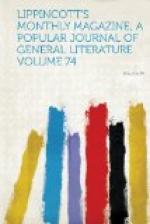In old and long-since-forgotten books concerning the conclaves many curious particulars may be found respecting the customs and ceremonies connected with the disposal of the body of the deceased pontiff. A learnedly antiquarian dispute has been raised on the question whether in early times the body of a pope was embalmed, as we understand the word, or only exteriorly washed and perfumed. It seems, on the whole, clear that the first pope who was, properly speaking, embalmed, was Julius II., who died in 1513. But here is a striking account of the condition of things in the papal palace after the death of that great, high-handed and powerful pontiff, Sixtus IV., which occurred in 1484, after a reign of thirteen years. The statement is that of Burcardo (Burckhardt), the papal master of the ceremonies, the same writer whose diary, jotted down from day to day, has revealed to us the incredible atrocities of the court of Alexander VI., the Borgia pope, who died in 1503. “For all that I could do,” writes the master of the ceremonies, who perhaps at that time occupied some less conspicuous post in the papal court, “I could not get a basin, a towel, or any kind of utensil in which the wine and the water for the odoriferous herbs could be put for washing the body of the deceased. Nor could I obtain drawers or a clean shirt for putting on the body, though I asked for them again and again. At length the cook lent me the copper kettle in which he was wont to heat the water for washing the plates, together with some hot water; and Andrew the barber brought me his barber’s basin from his shop. So the pontiff was washed. And as there was no towel to wipe the body with, I caused him to be wiped with the shirt in which he died, torn into two halves. I could not change the drawers in which he died and was washed, because there were no others. His canonical vestments were put upon him without any shirt, and a pair of red cloth stockings, furnished by the bishop of Cervia, who was his chamberlain, and a long tunic, if I remember rightly, of red damask, as well as some other things.” This pope, whose body was thus washed with his shirt torn in half for want of a towel, was that same Sixtus the enormous wealth and boundless luxury of whose nephews seem almost fabulous to readers even of these money-abounding days.
The explanation of the extraordinary state of things above described is to be found in the custom which existed of sacking the apartments of the deceased pope as soon as ever the breath was out of his body. The utter lawlessness which prevailed at Rome sede vacante—that is to say, during the interval between the death of one pope and the election of his successor—was not, indeed, confined to the residence of the departed pontiff. Throughout Rome all law used to be on those occasions in abeyance. The streets were scenes of the most unbridled excesses and violence of all sorts. That was the time for the satisfying of old grudges. Murder was




